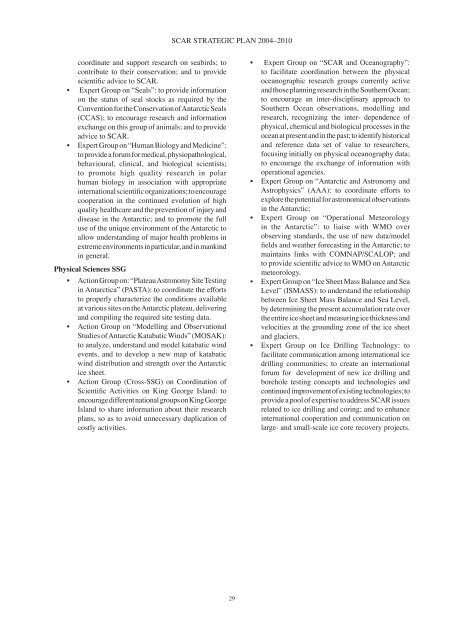SCAR Strategic Plan - Scientific Committee on Antarctic Research
SCAR Strategic Plan - Scientific Committee on Antarctic Research SCAR Strategic Plan - Scientific Committee on Antarctic Research
SCIENTIFIC COMMITTEE ON ANTARCTIC RESEARCH Annex 7
- Page 1 and 2: SCAR Strat
- Page 3 and 4: SCAR STRATEGIC PLA
- Page 5 and 6: SCIENTIFIC COMMITTEE ON ANTARCTIC R
- Page 7 and 8: SCIENTIFIC COMMITTEE ON ANTARCTIC R
- Page 9 and 10: SCIENTIFIC COMMITTEE ON ANTARCTIC R
- Page 11 and 12: SCIENTIFIC COMMITTEE ON ANTARCTIC R
- Page 13 and 14: SCIENTIFIC COMMITTEE ON ANTARCTIC R
- Page 15 and 16: SCIENTIFIC COMMITTEE ON ANTARCTIC R
- Page 17 and 18: SCIENTIFIC COMMITTEE ON ANTARCTIC R
- Page 19 and 20: SCIENTIFIC COMMITTEE ON ANTARCTIC R
- Page 21 and 22: SCIENTIFIC COMMITTEE ON ANTARCTIC R
- Page 23 and 24: SCIENTIFIC COMMITTEE ON ANTARCTIC R
- Page 25 and 26: SCIENTIFIC COMMITTEE ON ANTARCTIC R
- Page 27 and 28: SCIENTIFIC COMMITTEE ON ANTARCTIC R
- Page 29: SCIENTIFIC COMMITTEE ON ANTARCTIC R
- Page 33: SCIENTIFIC COMMITTEE ON ANTARCTIC R
<str<strong>on</strong>g>SCAR</str<strong>on</strong>g> STRATEGIC PLAN 2004–2010<br />
coordinate and support research <strong>on</strong> seabirds; to<br />
c<strong>on</strong>tribute to their c<strong>on</strong>servati<strong>on</strong>; and to provide<br />
scientific advice to <str<strong>on</strong>g>SCAR</str<strong>on</strong>g>.<br />
• Expert Group <strong>on</strong> “Seals”: to provide informati<strong>on</strong><br />
<strong>on</strong> the status of seal stocks as required by the<br />
C<strong>on</strong>venti<strong>on</strong> for the C<strong>on</strong>servati<strong>on</strong> of <strong>Antarctic</strong> Seals<br />
(CCAS); to encourage research and informati<strong>on</strong><br />
exchange <strong>on</strong> this group of animals; and to provide<br />
advice to <str<strong>on</strong>g>SCAR</str<strong>on</strong>g>.<br />
• Expert Group <strong>on</strong> “Human Biology and Medicine”:<br />
to provide a forum for medical, physiopathological,<br />
behavioural, clinical, and biological scientists;<br />
to promote high quality research in polar<br />
human biology in associati<strong>on</strong> with appropriate<br />
internati<strong>on</strong>al scientific organizati<strong>on</strong>s; to encourage<br />
cooperati<strong>on</strong> in the c<strong>on</strong>tinued evoluti<strong>on</strong> of high<br />
quality healthcare and the preventi<strong>on</strong> of injury and<br />
disease in the <strong>Antarctic</strong>; and to promote the full<br />
use of the unique envir<strong>on</strong>ment of the <strong>Antarctic</strong> to<br />
allow understanding of major health problems in<br />
extreme envir<strong>on</strong>ments in particular, and in mankind<br />
in general.<br />
Physical Sciences SSG<br />
• Acti<strong>on</strong> Group <strong>on</strong>: “Plateau Astr<strong>on</strong>omy Site Testing<br />
in <strong>Antarctic</strong>a” (PASTA): to coordinate the efforts<br />
to properly characterize the c<strong>on</strong>diti<strong>on</strong>s available<br />
at various sites <strong>on</strong> the <strong>Antarctic</strong> plateau, delivering<br />
and compiling the required site testing data.<br />
• Acti<strong>on</strong> Group <strong>on</strong> “Modelling and Observati<strong>on</strong>al<br />
Studies of <strong>Antarctic</strong> Katabatic Winds” (MOSAK):<br />
to analyze, understand and model katabatic wind<br />
events, and to develop a new map of katabatic<br />
wind distributi<strong>on</strong> and strength over the <strong>Antarctic</strong><br />
ice sheet.<br />
• Acti<strong>on</strong> Group (Cross-SSG) <strong>on</strong> Coordinati<strong>on</strong> of<br />
<str<strong>on</strong>g>Scientific</str<strong>on</strong>g> Activities <strong>on</strong> King George Island: to<br />
encourage different nati<strong>on</strong>al groups <strong>on</strong> King George<br />
Island to share informati<strong>on</strong> about their research<br />
plans, so as to avoid unnecessary duplicati<strong>on</strong> of<br />
costly activities.<br />
• Expert Group <strong>on</strong> “<str<strong>on</strong>g>SCAR</str<strong>on</strong>g> and Oceanography”:<br />
to facilitate coordinati<strong>on</strong> between the physical<br />
oceanographic research groups currently active<br />
and those planning research in the Southern Ocean;<br />
to encourage an inter-disciplinary approach to<br />
Southern Ocean observati<strong>on</strong>s, modelling and<br />
research, recognizing the inter- dependence of<br />
physical, chemical and biological processes in the<br />
ocean at present and in the past; to identify historical<br />
and reference data set of value to researchers,<br />
focusing initially <strong>on</strong> physical oceanography data;<br />
to encourage the exchange of informati<strong>on</strong> with<br />
operati<strong>on</strong>al agencies.<br />
• Expert Group <strong>on</strong> “<strong>Antarctic</strong> and Astr<strong>on</strong>omy and<br />
Astrophysics” (AAA): to coordinate efforts to<br />
explore the potential for astr<strong>on</strong>omical observati<strong>on</strong>s<br />
in the <strong>Antarctic</strong>;<br />
• Expert Group <strong>on</strong> “Operati<strong>on</strong>al Meteorology<br />
in the <strong>Antarctic</strong>”: to liaise with WMO over<br />
observing standards, the use of new data/model<br />
fields and weather forecasting in the <strong>Antarctic</strong>; to<br />
maintains links with COMNAP/SCALOP; and<br />
to provide scientific advice to WMO <strong>on</strong> <strong>Antarctic</strong><br />
meteorology.<br />
• Expert Group <strong>on</strong> “Ice Sheet Mass Balance and Sea<br />
Level” (ISMASS): to understand the relati<strong>on</strong>ship<br />
between Ice Sheet Mass Balance and Sea Level,<br />
by determining the present accumulati<strong>on</strong> rate over<br />
the entire ice sheet and measuring ice thickness and<br />
velocities at the grounding z<strong>on</strong>e of the ice sheet<br />
and glaciers.<br />
• Expert Group <strong>on</strong> Ice Drilling Technology: to<br />
facilitate communicati<strong>on</strong> am<strong>on</strong>g internati<strong>on</strong>al ice<br />
drilling communities; to create an internati<strong>on</strong>al<br />
forum for development of new ice drilling and<br />
borehole testing c<strong>on</strong>cepts and technologies and<br />
c<strong>on</strong>tinued improvement of existing technologies; to<br />
provide a pool of expertise to address <str<strong>on</strong>g>SCAR</str<strong>on</strong>g> issues<br />
related to ice drilling and coring; and to enhance<br />
internati<strong>on</strong>al cooperati<strong>on</strong> and communicati<strong>on</strong> <strong>on</strong><br />
large- and small-scale ice core recovery projects.<br />
29



